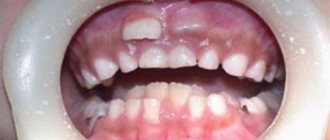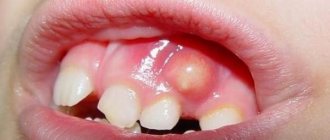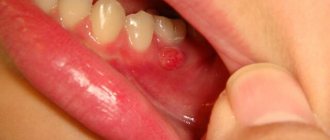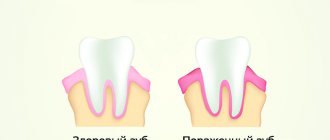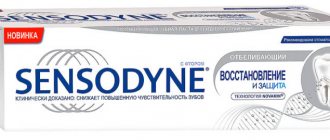Briefly about the disease
Flux (periostitis) is an inflammatory purulent disease of the periosteum caused by the penetration of infection from the carious cavity into the pulp. In the apical zone of the root, a periodontal abscess develops - a cavity filled with pus. Pus gets inside the gum tissue, it becomes inflamed, swollen, and swelling forms. From the outside, the flux looks like a lump or a bag of purulent contents.
The infection can be caused by untreated tooth decay, cysts, or gum pocket inflammation. Sometimes flux is discovered after jaw injuries. The symptoms of flux are pronounced, so it is impossible to miss the disease. Signs in children and the elderly are less pronounced due to the weakness of the body's defenses.
The acute stage of periostitis is manifested by the following symptoms:
- severe pain in the jaws, neck, head, which intensifies while eating;
- elevated temperature;
- redness of the gums;
- a tumor on the cheek that spreads to the lips, wings of the nose, and lower eyelid;
- general weakness and malaise;
- enlargement of the lymph nodes under the lower jaw, if this area is affected by inflammation.
The lump grows very quickly, this is accompanied by throbbing pain. After a few days, symptoms begin to subside. If the lump opens and the pus flows out, the person feels significant relief. But you can’t sit and wait to see if the flux will go away on its own . You need to see a doctor immediately.
Treatment of flux consists of the following measures:
- opening of the abscess after preliminary anesthesia;
- cleansing the periosteum area;
- antiseptic treatment;
- installation of drainage for the outflow of pus.
Then the doctor prescribes individual treatment, usually antibiotics to eliminate the inflammatory process and increase immunity:
- "Tsifran";
- "Amoxiclav";
- "Tsiprolet";
- "Amoxicillin."
At the same time, they take immunomodulators and vitamins.
After final cleansing of pus, the drainage is removed. The gum may heal on its own, or it may have to be sutured. After this, caries treatment is carried out. If the process has gone far, the tooth needs to be removed.
Oksana Shiyka
Dentist-therapist
Important! Flux treatment should only take place in a dental clinic using anesthesia.
Sometimes purulent inflammation cannot be stopped immediately; treatment will be longer and more complex. But usually the symptoms of the disease pass quickly, usually after 12-15 hours, the wound heals after surgery.
Other treatments
Treatment always includes local and general methods. Both surgical and therapeutic. It takes at least a week from the moment you visit the dentist until complete recovery.
Local treatment
The first stage of treatment is opening the abscess - a purulent sac. It is performed regardless of whether the causative tooth will be preserved or it will be decided to remove it.
Stages:
- Gum section. First, the doctor administers local anesthesia, then cuts the gum tissue with a scalpel. The incision is usually no more than 1-2 cm in length.
- Cleaning out purulent contents. The cavity is sterilized - washed with antiseptic solutions.
- Drainage. To prevent the edges of the wound from sticking together and preventing the outflow of pus and ichor, a special rubber strip is inserted into the wound - drainage.
General treatment
Aimed at eliminating the cause of the flux. If the disease develops against the background of pulpitis, the dentist drills out hard tissues affected by caries, removes the pulp and cleans the root canals - conducts full endodontic treatment.
In case of periodontitis, the necrotic pulp is removed (if it has not been removed previously), and the canals are sterilized. If they were sealed before, they are sealed again. When treating pulpitis and periodontitis complicated by flux, the tooth is not immediately closed with a temporary filling, leaving the opportunity for pus to escape through the canals.
If the cause of the flux is a tooth with an artificial crown or pin, the canals are not touched, but after the inflammatory process is removed, a resection of the apex of the diseased root is performed, that is, it is cut off. If it is impossible to carry out endodontic treatment, the causative tooth is removed. For example, if the crown is destroyed by more than 50% and cannot be restored with a pin, stump inlay or crown. Such teeth have no functional value and cannot be preserved.
We suggest you read: Pain in the ear when swallowing: causes and treatment
If the disease occurs due to periodontitis, no operations are performed on the tooth. The abscess is opened and subsequently undergoes periodontal treatment.
Resection of the apex of the tooth root with flux
In addition to local and general treatment, 5-7 sessions of physiotherapeutic procedures are prescribed. Relieves inflammation:
- fluctuarization – therapeutic effect on tissues with alternating current of low voltage;
- electrophoresis with lidase - with the help of current, the medicine actively spreads through damaged tissues;
- ultra-high frequency therapy – treatment with an electromagnetic field;
- exposure to ultrasound – tissue massage at the cellular level, stimulating regeneration;
- laser therapy is exposure to laser light that enhances the effect of drug therapy.
Chamomile baths help very well with flux. To prepare a medicinal solution, you need to take a tablespoon of flowers, pour boiling water (200 ml) and set aside for 20 minutes; you need to make baths with a warm solution, hot water can cause severe pain.
To prevent flux from appearing, it is important to follow the doctor’s recommendations regarding prevention.
Why is flux dangerous?
Flux requires immediate medical attention, since in an advanced situation it can even lead to death. Therefore, the question of whether the flux can go away on its own should not even be discussed. You cannot expect the symptoms to become weaker and the pus to drain out on its own. The disease can cause dangerous consequences:
| Complication | How does it manifest? | How to fix it? |
| Repeated abscesses | Extensive purulent process with tissue swelling, fever, bad breath, sleep and appetite disturbances. | Requires drainage and drug treatment. |
| Tissue necrosis | Inflammation leads to cell death and the formation of large areas of necrosis. | |
| Cellulitis | Inflammation of the subcutaneous layer and intermuscular tissue, manifested by difficulty breathing, pain and immobility of the jaw, and inability to speak. Purulent inflammation occurs without a restrictive membrane (as in an abscess), and therefore spreads freely throughout all surrounding tissues. | Surgical treatment, drainage, antibiotics. |
| Sepsis | Blood poisoning often leads to disability or death of the patient. Pus spreads throughout the body, reaching the brain. Cardiac arrest, coma, or anaphylactic shock may occur. | Measures to save the patient's life. |
| Osteomyelitis of the jaw | The pus spreads to neighboring areas. Extensive inflammatory process covering the entire jaw. Leads to meningitis, brain abscess. | Surgery. |
Oksana Shiyka
Dentist-therapist
Note! The fulminant form of sepsis develops within 2 days. The infection spreads through the bloodstream and penetrates all tissues and organs.
Sometimes flux forms on the palate due to the occurrence of a palatal abscess. As the size increases, the transverse palatal folds are smoothed out, inflammation covers the soft palate, and swallowing becomes difficult. Palatal flux is also treated by opening it to allow free drainage of the pus.
With untimely or improper medical care, the purulent “sac” sometimes ruptures, after which the pus spreads, can penetrate the blood and spread throughout the body. This poses a serious threat.
Purulent periostitis has 2 forms: chronic and acute. Chronic lasts several months. Sometimes no visible appearances are observed until the flux reaches an impressive size and begins to interfere with chewing.
Oksana Shiyka
Dentist-therapist
Important! At the initial stage, the disease occurs without the formation of an abscess. At this stage, treatment with antibiotics and painkillers is prescribed. In the acute stage, only surgical intervention is required.
Is it possible to do something at home and will it be effective?
Oksana Shiyka
Dentist-therapist
Important! You cannot self-medicate, since the only way to cure gumboil is to open it, clean the cavity, therapeutic treatment of dental caries, and in advanced cases, removal.
Do not apply hot compresses to the inflamed area, heat it, or try to open it. You should not take painkillers before a medical examination, as this will complicate the diagnosis. Sometimes a person does not go to the clinic, takes painkillers, and after a few days the severe pain begins to subside, and sometimes goes away completely. But you can't be happy. This means that the nerve has died due to infection, so the person does not feel pain. The inflammatory process increases, penetrates into the deep tissues, and the purulent process covers the gums and cheek.
Can flux go away on its own without surgery? In some situations, the flux opens spontaneously, the patient feels relief, but this is temporary. It is recommended to go to the doctor on the same day, since the inflammatory process continues and needs to be stopped. To do this, the cavity must be opened and cleaned of purulent contents. Before visiting the clinic, it is recommended to rinse your mouth with a soda solution and try not to eat. Self-treatment is possible after surgery in a clinic. Recommended mouth rinses:
- Decoctions of calendula, chamomile, sage.
- Tinctures of eucalyptus and cloves in alcohol, diluted with water in a ratio of 1: 2.
- "Chlorhexidine" 0.5%. Keep in mouth for 5 minutes three times a day.
- "Chlorophylliptom". 1 tbsp. l per glass of water.
- A solution of salt and soda, 1 tsp per glass of water;
- Oak bark. 2 tbsp. l pour 300 ml of boiling water, leave for half an hour. Several times a day.
- Green tea. 2 tbsp. l per glass of boiling water.
- Sage. Brew as tea alone or mixed with green tea.
It is not recommended to use alcohol lotions and rinses. You should not drink aspirin after surgery, as it provokes bleeding, apply compresses and lotions,
Oksana Shiyka
Dentist-therapist
Important! Any traditional methods and drug treatment are useless if the abscess is not opened and the cavity is cleansed. Symptoms may subside for a while only to appear with renewed vigor.
Sometimes a hypertonic salt solution helps to cope with purulent inflammation. 1 tsp per 0.5 liter of water. Place in mouth and hold for 4-7 minutes. Spit it out, take a new portion, and hold for 4-7 minutes. Repeat until all the solution is gone. Sometimes this method helps to draw out pus even without surgical treatment.
How to lose weight in a sauna
Forget about beer! The bath reduces the level of fluid in the body, and you need to be very careful with drinking. With reasonable gradual warming up, you can get rid of a kilogram or one and a half pounds of excess weight in one visit to the bathhouse. But if you try to achieve more, you will most likely do it to your detriment:
- Your body is not a testing ground for implementing stupid ideas and conducting crazy experiments!
- Everything in it is interconnected. Consult your doctor! You are disappointed? Alas. Eating excess weight is easier than getting rid of it. And if we are talking about metabolic disorders, then nothing should be done without a doctor who has his own picture and strategy for dealing with your sores. If only because the doctor is smarter. He knows what he's doing, but you don't always.
It is important to remember: the fight against fat (let's call a spade a spade) with the help of a bath is no less tiring and painful than exercise and diet. Only as a result of significant dehydration does the body give the stoker cells the command: “Burn fats!” And for this you need to take a good steam and not drink anything at all! Are you capable of this?
Flux prevention
To prevent flux, caries prevention is necessary, since flux develops as a result of neglected caries. To avoid gumboil, you need to treat your teeth in time and eliminate foci of inflammation. Otherwise, bacteria gradually destroy tissue, reach the periosteum and provoke inflammation in this area.
To prevent caries from developing, you need to:
- brush your teeth in the morning and before bed;
- buy a soft brush, fluoride paste;
- rinse your mouth after eating;
- promptly remove tartar and soft plaque, since they become a favorable environment for the life of microbes.
Preventative dental examinations should become the rule. This is done 2 times a year. Establish proper nutrition, eat more raw vegetables and fruits.





